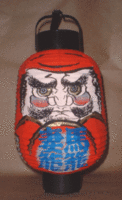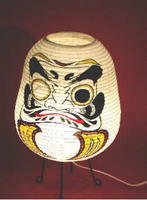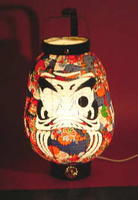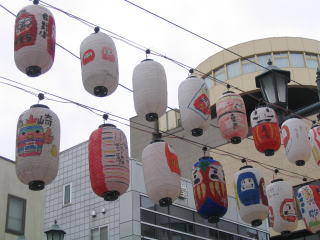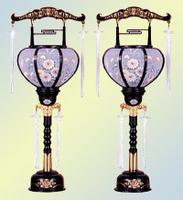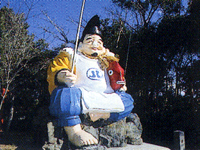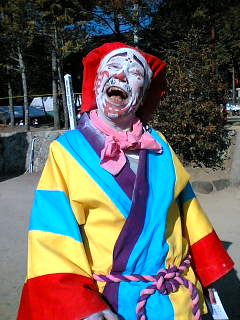:::::::::::::::::::::::::::::::::::::::::::::::::::::::::::::::::::::::::::::::::::::::::::::::::::::
DARUMA ... Additions 2009
Hoo no Yama 法の山 Mountain of the Buddhist Law Kyoto
Koma 独楽(コマ)spinning top, tops Kreisel
Temple Jinmu-Ji, Fudo Myo-O and Yakushi Nyorai 薬師如来
(Jimmuji 神武寺) in Zushi Town, Kanagawa prefecture
Marishiten 摩利支天 Marishi Ten
Masamune, Daruma Masamune 達磨正宗 Old Sake rice wine
福だるま(Cotyledon) コチレドン
チワワエンシス(Echeveria)
Daruma Fukumusum だるま福娘 / 達磨福娘 plant
hangonkoo, hankonkoo 反魂香 soul-returning incense
Hangonko
hangontan 反魂丹 Hangontan medicine from Toyama
Hirayama Ikuo 平山郁夫 (1930 - 2009)
Datsueba 奪衣婆 or 脱衣婆 the Old Hag of Hell
.
Yushima Tenjin 湯島天神 Yushima Tenmangu and Sugaware Michizane
O-Mamori 不動明王 お守り Talismans with Fudo Myo-O
Daruma cookies from Nara
Ike, Daruma Ike だるま池 Ponds named Daruma
Musume Dojoji 娘道成寺 (musume doojiji) Kabuki play and Nakamura Tomijuro
Himiko, Yamataikoku and Yoshinogari 卑弥呼 / 邪馬台国 / 吉野ヶ里 in Saga, Kyushu
Magazine Articles
Japan Illustrated Autumn 1974
週刊 世界百不思議 : 「だるまさん」が招ぶ 開運講座 (Japanese)
Fukuyama Exhibition Summer 2009 「福よこい!だるま大百科」展
広島県福山市 日本郷土玩具博物館
Yufuin Hot Spring and Mount Yufudake 湯布院 / 由布岳 Kyushu
Zen no Tomo 禅の友 magazine of the Soto sect. and Momiji Daruma
Sanpo-Ji Temple 三寳寺 (さんぽうじ 三宝寺) with Daruma mikuji
Bonji Daruma 梵字だるま with sanskrit letters and Bonji Mandala 梵字曼陀羅
Kunisada Chuuji (国定 忠治) (1810-1851) Kunisada Chuji, a Robin Hood of Japan
Maguro だるまマグロ Daruma Maguro Tuna fish named DARUMA
Riizento daruma リーゼントだるま "Regent Daruma" regent hairstyle, pompadur hairstyle
Taiyaki Kanda Daruma (たいやき 神田達磨) waffles in the form of sea bream
Sayama Fudo Temple 不動寺 amd Fudo yaki 不動焼き waffles
The Heart of Enlightenment
Buddhist Art in China Museum für Ostasiatische Kunst, Köln
Sue Sarasa Museum 寿恵更紗ミュージアム Kyoto
Kuchi-e くちえ【口絵】 frontispice and the Great Ansei Earthquake Ansei (安政)
Revenge Story of the Soga Brothers (Soga monogatari 曾我物語) and related kigo including Lady Tora (Tora gozen 虎御前)
Chataku 茶托saucer for tea cup and Negoro Laquer ware
Shibata Zeshin 柴田是真 (1806 - 1891)
Meditation in Nature
Dogu (doguu 土偶) clay figurines of the Jomon period
Tatami Daruma 畳だるま made from tatami mat pieces
ukiwa 浮き輪 Swim ring
.
Shishigatani kabocha 鹿ヶ谷かぼちゃ pumpkin from Shishigatani, Kyoto
Tokoname yaki 常滑焼 Tokoname pottery
Kyuusu 急須 Kyusu Teapot だるま急須 Daruma Kyusu ダルマ急須
Tabi 足袋 and toe socks 五本指 ソックス
Kanzashi かんざし / 簪 hairpin
Katsuobushi kezuriki かつおぶし削り器 cutter for bonito flakes
Zenringai 禅林街 Temple District in Hirosaki
Nioibukuro 匂い袋 / 匂袋, Fragrance bag, Duftbeutel, Sachet
Toonyuu とうにゅう (豆乳) soy milk with Daruma label
Kyuusu (kyusu) 急須 Small teapots with a handle to poor tea
Furoshiki 風呂敷 Cotton wrappers Hankerchief ハンカチ hankachi and gamakuchi がま口 purse
Wata, Daruma Wata だるまわた Cotton Items momen
Putter cover パターカバー
Bukku kabaa ブックカバー Book cover, book covers and book cover design
Tonbodama, Tombodama (とんぼだま蜻蛉玉) Dragonfly Glass Beads
Hanamaki Tsuchi Ningyoo 花巻人形 Clay dolls from Hanamaki Iwate prefecture
Kurofune monaka 黒船最中 Black Ship wafers and a kyoka poem
Pan, Daruma pan だるまパン Daruma bread and
Daruma monaka だるまもなか Daruma wafers
Hoshitsuji Daruma 星辻だるま "star Daruma"
Hibuse Daruma 火伏せだるま warding off fire
Daruma Festival at Hoshitsuji Shrine in Akita
Sankaku Daruma 三角だるま・三角ダルマ Triangular, conical Daruma
Temple Saihoji 西方寺 and Haiku by Issa Story of UBAZAKURA 姥桜
Tenbin Daruma だるま天秤 pair of scales, for fishermen
Darumaru maskot from Gunma prefecture だるまる and Darumaruma だるまるま
Karimaruya Design Daruma かりまる屋
nichi nichi kore kōnichi (日々是好日) Every Day is a Good Day
hibi kore koojitsu / hibi kore yoki hi
Sono Kara Matsuri 園韓神祭 (そのからかみまつり) Festival for Sonokami and Karakami and the NUE 鵺 mythological beast
Tsugaru Daruma 津軽だるま Utou-bori Daruma 善知鳥彫だるま
Tokachi Daruma 十勝だるま From Stone Hokkaido
Gokayama Daruma 五箇山の達磨 and Shirakawa Daruma 白川だるま
Senkyo Daruma 選挙だるま Victory Daruma to win the election 2009 衆院総選挙
Byodo-In and the Phoenix Hall in Uji 平等院,鳳凰堂
Kanei-Ji Temple and Tenkai (Jigen Daishi) 寛永寺(かんえいじ)
and 慈眼大師. Ueno, Tokyo
hoosoo-e 疱瘡絵 prints to protect children from smallpox
. . . . . red prints 赤絵 aka-e
Utagawa Shigenobu 歌川重宣(Hiroshige II 二代歌川広重) and Daruma play prints
Ishikawa ken kinpaku 石川県金箔製品 だるま Daruma with goldfoil from Ishikawa prefecture
Enpitsu 鉛筆 Pencil with Daruma
USB Memory USBメモリー 2 GB of Daruma Memory だるまさんの記憶
Hamamatsu Daruma Market 浜松市の虚空蔵尊とだるま市
Kuroji 黒字の炭だるま .. Black Daruma sumi Daruma 炭だるま charcoal Daruma
Sanada Yukimura 真田幸村 and Shogun Daruma 武将達磨
YAMADARUMA BLOG 山田るま
Daruma Odori だるま踊り Daruma Dance
Daru Chan だるチャン a DARUMA BLOG
Daruma Exhibition at Kawagoe Museum
川越市立博物館へだるま展
Karee カレー
, Daruma Curry だるまカレー with a snowman Daruma from rice
Yakyu Shrine 箭弓神社 and baseball bat ema バット絵馬
Sakamoto Ryoma Daruma Guinomi 坂本竜馬ダルマぐい呑み sake cup from Tosa
Tabemono to gangu 食べ物と玩具 Traditional Dolls and Food
Daruma celebrating a good catch 大漁だるま
Amanatto (amanattoo) 甘納豆 sugar-glazed beans
and Daruma gummi sweets だるまグミ
Togarashi, toogarashi 唐辛子 red hot pepper Shichimi Togarashi and more
Matsue Festivals 松江 : Horan Enya Boat Festival ほうらんえんや Hooran Enya and other festivals
Naa-san なーさん
Manga-Cat だるまなーさん
Namaketaroo Daruma Ponpon なまけたろう だるまポンポン The Lazy Taro Daruma Ponpon
Ningyooyaki, ningyoyaki だるま人形焼 "Figure waffles"
Daikon だるま大根 Daruma Daikon radish named Daruma
Shuuban 宗判 temple stamps of identification
Dantsu 段通/緞通 Japanese carpets
Oyatsu お八つ an apple Daruma snack
Tanaka Iichiro 田中偉一郎 Drop-eyed Daruma
Tatoo Teeshirt of Fudo Myo-O
Hoonensai 豊年祭 Festival for a bountiful harvest "Penis Festival", at Tagata Shrine, Aichi prefecture
Botamochi Jizo ぼた餅地蔵 Jizo Bosatsu, Botamochi rice cakes and children
Mawashi, keshoo mawashi 化粧まわし Sumo wrestlers decorated belt of Takamiyama
Shokado Shojo 松花堂昭乗 (Shookadoo Shoojoo (1584 - 1639)) and the Shokado Bento 松花堂弁当
Kukkii だるまクッキーDaruma cookies Daruma sweets だるまやスイーツ
Pan, yukidaruma pan ゆきだるまパン Snowman Daruma as Bread
Kubikiri Jizoo 首切り地蔵 Jizo with his head cut off
Miso, dai daruma miso 大だるまみそ ... a miso paste called BIG DARUMA
Dengakumai, dengaku mai 田楽舞 dance and food
Ika Daruma Ika Surume だるまいか / いかだるま
Tosa Nikki, Tosa Diary by Kin no Tsurayuki ...
Myoga Ginger (myooga) 茗荷 and shrine rituals
Kowloon, The Legend of The Nine Dragons and
Dragon Riding Clouds
Wilson Shieh, modern gongbi painter Hongkong
Tada Toshiko, Potter from Ishikawa
Katsura Rikyu (Katsura rikyuu 桂離宮 ) Imperial Villa in Kyoto
Totoro Daruma トトロだるま / Daruma Totoro 達磨トトロ My Neighbour Totoro
Art DE Daruma Exhibition アートDEだるま展 Tokyo.
NORAKURO DARUMA のらくろだるま and other designer dolls handcrafted by Shin Tsuzuki
Alien Daruma, Kapa Daruma, Mosaic Daruma, Sea lion Daruma, Snowman Daruma, Oni Daruma, Jack O' Daruma (haloween), Kappa Daruma
Jirochoo and Ishimatsu Daruma 次郎長だるま . 石松だるま
Shooshuu 消臭たまご Air Freshener, Air Deodorant
Ondo and Darumamonie ダルマ音頭 / ダルモニーSong and Dance with Daruma
Ashura, Asura (あしゅら) 阿修羅
Yamamoto Kansuke 山本勘助だるま鈴 Clay Bell
:::::::::::::::::::::::::::::::::::::::::::::::::::::::::::::::::::::::::::::::::::::::::::::::::::::
ALL ... Latest Additions from 2009
ALL ... Latest Additions from 2008
ALL ... Latest Additions from 2007
ALL ... Latest Additions from 2006
ALL ... Latest Additions from 2005
:::::::::::::::::::::::::::::::::::::::::::::::::::::::::::::::::::::::::::::::::::::::::::::::::::::
To the Daruma Museum ABC Index
http://darumasan.blogspot.com/
World Kigo Database
Daruma Museum Waitinglist
. . . . . . . . . . . . NEW BLOG
Daruma Museum Archives since 2007
:::::::::::::::::::::::::::::::::::::::::::::::::::::::::::::::::::::::::::::::::::::::::::::::::::::

[ . BACK to DARUMA MUSEUM TOP . ]
:::::::::::::::::::::::::::::::::::::::::::::::::::::::::::::::::::::::::::::::::::::::::::::::::::::
















